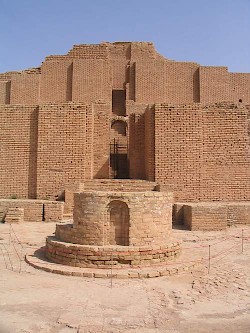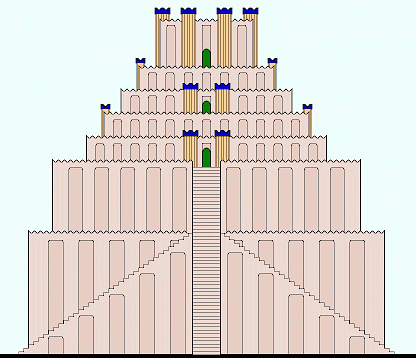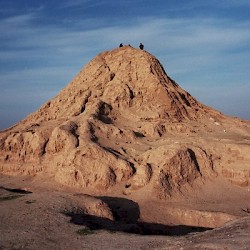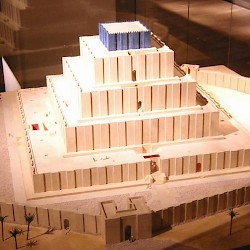Ziggurat
Ziggurat: a multi-storied temple tower from ancient Mesopotamia.

Ziggurats are, architecturally, the Mesopotamian equivalent of the Egyptian pyramids: large artificial square mountains of stone. They are equally ancient. But there are two differences: a ziggurat was not a tomb but a temple, and ziggurats were built well into the Seleucid age, whereas the building of pyramids came to an end after c.1640 BCE. Ziggurats are, briefly, temple towers.
Our word ziggurat is derived from ziqqurratu, which can be translated as "rising building" (Akkadian zaqâru, "to rise high"). Some of them rose very high indeed. The temple tower known as Etemenanki (the 'House of the foundation of heaven on earth') in Babylon was 92 meters high. Even larger was the shrine of the god Anu at Uruk, built in the third or second century BCE. The best preserved temple tower is at Choga Zanbil in Elam, modern Khuzestan in Iran.
Ziggurats played a role in the cults of many cities in ancient Mesopotamia. Archaeologists have discovered nineteen of these buildings in sixteen cities; the existence of another ten is known from literary sources.
They were always built by kings. In third millennium BCE Mesopotamia, there was a conflict between the two great organizations, the temple and the palace. By building ziggurats, the king showed that he could perform more impressive religious deeds than the priesthood.

The most famous ziggurat is, of course, the "tower of Babel" mentioned in the Biblical book Genesis: a description of the Etemenanki of Babylon. According to the Babylonian creation epic Enûma êliš the god Marduk defended the other gods against the diabolical monster Tiamat. After he had killed her, he brought order to the cosmos, built the Esagila sanctuary, which was the center of the new world, and created humankind. The Etemenanki was next to the Esagila, and this means that the temple tower was erected at the center of the world, as the axis of the universe. Here, a straight line connected earth and heaven. This aspect of Babylonian cosmology is echoed in the Biblical story, where the builders say "let us build a tower whose top may reach unto heaven".
 Ur, Ziggurat |
 Aššur, Ziggurat |
 Borsippa, Ziggurat |
 Choga Zanbil, Ziggurat, Model |